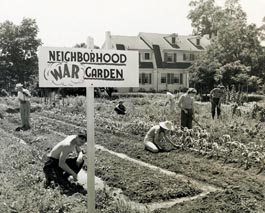home | metro silicon valley index | the arts | visual arts | review

Courtesy History San Jose
DOING THEIR PART: In 1943, a war garden flourishes on the Polhemus home property on Stockton Avenue in San Jose.
The Valley At War
History San Josť's new exhibit shows how Santa Clara Valley coped on the 'Home Front' during World War II
By Jack Van Zandt
PEOPLE UNDER 60 usually think of World War II in terms of fathers or grandfathers battling enemies on Pacific islands and in European fields or through iconic images of Iwo Jima, D-Day and the atomic bomb. We often forget that the last formally declared U.S. war also absorbed the entire population of our country in a massive coordinated effort to defeat ideologically driven enemies that really did threaten our very existence as a nation.
A new History San Josť exhibit shows how Santa Clara County, on the western domestic front of the war, played a significant part in that effort and how the war affected the everyday lives of people in the valley. The show, which opened on Dec. 7, the 67th anniversary of Pearl Harbor, is called The Home Front: Santa Clara County's World War II, and it was put together by Melissa Johnson, curator of interactive media at HSJ. The show tells the story of the "folks back home" during the war years through displays of period household objects, civil-defense paraphernalia, fashions, photographs, posters, letters, archival documents, periodicals and specially produced audiovisual material.
Popular music from the period playing throughout the exhibit sets the tone for the journey back in time. The next level of the experience is based on carefully chosen San Jose News front pages placed at each stage of the exhibit, chronologically traveling through the war's big stories from Pearl Harbor and President Roosevelt's address to Congress the next day to the explosion of the "sun bomb" over Hiroshima on Aug. 6, 1945 (headline: "New Weapon Cost $2 Billion, Most Terrible Ever Seen").
A display showing a typical kitchen anchors the exhibition, followed by a correspondence section. Letters from soldiers in far-off places—including ones from Harry Farrell, future San Jose journalist and author—bring the action on the front to friends and family back home. The civil-defense materials on show remind visitors of the careful preparations that were made to provide aid to citizens in the event of an enemy air attack. There is a map showing each precinct in San Jose and the location of air-raid sirens and strategically placed emergency supplies, first aid kits and stretchers.
The many factories dedicated to war manufacturing and food canning in the valley that employed large numbers of women provide the materials for another display. There are photos and documents related to the Hendy Ironworks in Sunnyvale that made engines for liberty ships, the Libby's canning factory in San Jose, and the first IBM plant that opened in 1943 to make punch cards.
On Feb. 19, 1942, President Roosevelt signed Executive Order 9066, giving his military commanders the power to designate "exclusion zones" for any military purposes they felt necessary. In March, U.S. Army Gen. John DeWitt, commander of the U.S. Fourth Army and the Western Defense Command, used Roosevelt's order as a pretext to exclude both citizens and noncitizens of Japanese ancestry from the Western United States, declaring them "undesirables" and a danger to national security.
Japanese-Americans living in the Western states were first subject to curfews and banned from owning firearms, radios and cameras. Nearly 120,000 Japanese-Americans, 75 percent of them citizens, were rounded up with what possessions they could carry and moved into internment camps. Many from San Jose were sent to the Heart Mountain camp in Wyoming. In December 1944, the U.S. Supreme Court declared the internment of citizens unconstitutional, and the detainees began leaving the camps in 1945. In cooperation with the Japanese-American Museum, there is a display of documents and photographs related to Japanese internment, including a number of "loyalty oath" documents with photographs and personal information that each person was required to sign.
San Francisco.com Real Estate
Moving to the Bay Area just became easy. Let San Francisco.com show you all the homes currently for sale.
San Jose.com Real Estate
Relocating to San Jose or Silicon Valley? Let San Jose.com introduce you to some expert area real estate agents.
The exhibition concludes with items from the end-of-war celebrations. There is also an interactive audiovisual presentation of interviews where local citizens tell the stories of their experiences during the war over sequences of photos from their personal collections. Many of these are also available at www.stories-of-service.org, a production of HSJ and the Digital Clubhouse Network.
THE HOME FRONT: SANTA CLARA COUNTY'S WORLD WAR II runs through Sept. 11, 2009, in the Pacific Hotel Gallery in History Park, 1650 Senter Road, San Jose.
Send a letter to the editor about this story.
|
|
|
|
|
|
